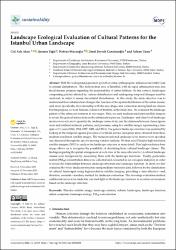| dc.contributor.author | Aksu, Gül Aslı | en_US |
| dc.contributor.author | Tağıl, Şermin | en_US |
| dc.contributor.author | Musaoğlu, Nebiye | en_US |
| dc.contributor.author | Seyek Canatanoğlu, Emel | en_US |
| dc.contributor.author | Uzun, Adnan | en_US |
| dc.date.accessioned | 2022-12-23T14:25:43Z | |
| dc.date.available | 2022-12-23T14:25:43Z | |
| dc.date.issued | 2022-12 | |
| dc.identifier.citation | Aksu, G. A., Tağıl, Ş., Musaoğlu, N., Seyek Canatanoğlu, E. & Uzun, A. (2022). Landscape ecological evaluation of cultural patterns for the Istanbul urban landscape. Sustainability (Switzerland), 14(23), 1-26. doi:10.3390/su142316030 | en_US |
| dc.identifier.issn | 2071-1050 | |
| dc.identifier.uri | https://hdl.handle.net/11729/5178 | |
| dc.identifier.uri | http://dx.doi.org/10.3390/su142316030 | |
| dc.description | This research was carried out in the scope of the project titled “Istanbul-Besiktas District an Ecological Planning Approach for an Urban Landscape Plan and Implementation Strategy” funded by The Scientific and Technological Research Council of Turkey (TUBITAK) with the project number 114O341-TOVAG. We are grateful to TUBITAK for their support. | en_US |
| dc.description.abstract | With the widespread population growth in cities, anthropogenic influences inevitably lead to natural disturbances. The metropolitan area of Istanbul, with its rapid urbanization rate, has faced intense pressure regarding the sustainability of urban habitats. In this context, landscapes comprising patches affected by various disturbances and undergoing temporal changes must be analyzed, in order to assess city-related disturbances. In this study, the main objective was to understand how urbanization changed the function of the spatial distribution of the urban mosaic and, more specifically, its relationship with the size, shape, and connection among land-use classes. For this purpose, we took Besiktas, a district of Istanbul, as the study area. We evaluated the landscape pattern of the urban environment in two stages. First, we used medium-resolution satellite imagery to reveal the general interactions in the urbanization process. Landscape- and class-level landscape metrics were selected to quantify the landscape connectivity, and the distances between classes (green areas and artificial surfaces), patterns, and processes, using five satellite images representing a time span of 51 years (1963, 1984, 1997, 2005, and 2014). The general landscape structure was examined by looking at the temporal–spatial processes of artificial surface and green areas obtained from these medium-resolution satellite images. The trends in selected landscape-level metrics were specified and discussed through the use of a moving window analysis. We then used Pleiades high-resolution satellite imagery (2015) to analyze the landscape structure in more detail. This high-resolution base image allows us to recognize the possibility of classifying basic cultural landscape classes. The findings regarding the spatial arrangement of each class in the areas allocated to 14 cultural landscape classes were interpreted by associating them with the landscape functions. Finally, particulate matter (PM10) concentration data were collected and evaluated as an ecological indicator, in order to reveal the relationships between landscape structure and landscape function. In short, we first evaluated the whole landscape structure using medium-resolution data, followed by the classification of cultural landscapes using high-resolution satellite imagery, providing a time-effective—and, therefore, essential—auxiliary method for landscape evaluation. This two-stage evaluation method enables inferences to be made that can shed light on the landscape functions in an urban environment based on the landscape structure. | en_US |
| dc.language.iso | eng | en_US |
| dc.publisher | MDPI | en_US |
| dc.relation.isversionof | 10.3390/su142316030 | |
| dc.rights | info:eu-repo/semantics/openAccess | en_US |
| dc.subject | Cultural landscapes | en_US |
| dc.subject | Landscape ecology | en_US |
| dc.subject | Landscape function | en_US |
| dc.subject | Landscape pattern | en_US |
| dc.subject | Pleiades satellite image | en_US |
| dc.subject | PM10 concentration | en_US |
| dc.subject | Urban ecosystem | en_US |
| dc.subject | Remote-sensing data | en_US |
| dc.subject | Methodological approach | en_US |
| dc.subject | Ecosystem services | en_US |
| dc.subject | Air-pollution | en_US |
| dc.subject | Green space | en_US |
| dc.subject | Metrics | en_US |
| dc.subject | Sustainability | en_US |
| dc.subject | Urbanization | en_US |
| dc.subject | Simulation | en_US |
| dc.subject | Science | en_US |
| dc.title | Landscape ecological evaluation of cultural patterns for the Istanbul urban landscape | en_US |
| dc.type | article | en_US |
| dc.description.version | Publisher's Version | en_US |
| dc.relation.journal | Sustainability (Switzerland) | en_US |
| dc.contributor.department | Işık Üniversitesi, Sanat, Tasarım ve Mimarlık Fakültesi, İç Mimarlık ve Çevre Tasarımı Bölümü | en_US |
| dc.contributor.department | Işık University, Faculty of Arts, Design and Architecture, Department of Interior Architecture and Environmental Design | en_US |
| dc.identifier.volume | 14 | |
| dc.identifier.issue | 23 | |
| dc.identifier.startpage | 1 | |
| dc.identifier.endpage | 26 | |
| dc.peerreviewed | Yes | en_US |
| dc.publicationstatus | Published | en_US |
| dc.relation.publicationcategory | Makale - Uluslararası Hakemli Dergi - Kurum Öğretim Elemanı | en_US |
| dc.contributor.institutionauthor | Uzun, Adnan | en_US |
| dc.relation.index | WOS | en_US |
| dc.relation.index | Scopus | en_US |
| dc.relation.index | Social Sciences Citation Index (SSCI) | en_US |
| dc.relation.index | Science Citation Index Expanded (SCI-EXPANDED) | en_US |
| dc.description.quality | Q2 | |
| dc.description.wosid | WOS:000896542700001 | |


















